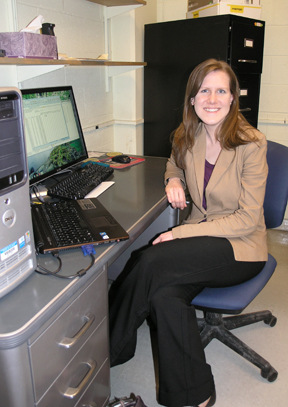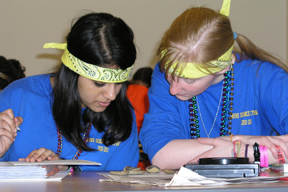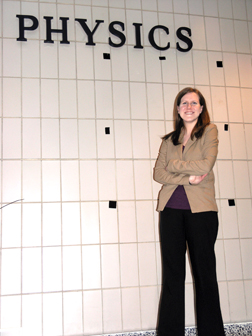STEM Pipeline Alive and Well as
Science Olympiad Impacts Former Contestant's STEM Career Choice
May 25, 2011

Dr. Jennifer Docktor, Illinois postdoc.
GET YOUNGSTERS HOOKED ON STEM when they're young, and when they're old, they'll choose STEM careers! Theoretically, that's how the STEM (science, engineering, technology and/or mathematics) pipeline is supposed to work, and Dr. Jennifer Docktor's journey along the pipeline is a perfect example. She began her voyage by getting involved in Science Olympiad at the age of 12 and credits her years in the science competition as playing a big part in her decision to enter the field of physics education.
Docktor wasn't particularly interested in science prior to joining her school's Science Olympiad team. In fact, when first asked to join, she declined; however, her wily junior high life science teacher (incidentally also the coach for the junior high Science Olympiad team), after unsuccessfully pestering her to get involved, convinced one of her girlfriends in class to join. Dragged along to the informational meeting by her friend, she was hooked from that point on. (It also didn't hurt that her team won the North Dakota state tournament and went to the Science Olympiad National Tournament [SONT] her first year!) In fact, her school's team went to SONT for five of the six years she was involved. Regarding Jamestown High School's amazing and, possibly unprecedented, record of being 1st in her state and, thus, advancing to the national tournament for all those years, Docktor modestly replied, "We had some really good science teachers, some good coaches, and some really motivated students at that time." In addition to the challenge of scientific competition and the thrill of victory, one of the perks of going to the national tournament so often was that she got to see quite a bit of the country: Tuscon, Arizona; Bloomington, Indiana; Atlanta, Georgia (the same year the Olympics was there—1996); Grand Rapids, Michigan; and in her senior year, Chicago, Illinois.
Along with having a lot of science teachers who inspired her, Docktor credits Science Olympiad as playing a big part in her choosing science as a career. "I think that Science Olympiad was the critical factor in getting me interested in science to begin with. When I was in seventh grade or in junior high, I don't think I would have become interested in science without being part of the Science Olympiad at that age. It helped develop that interest over the years. During the six years that I was in it, it gave me confidence that I could be successful; it made me see that I was interested in pursuing this as a future career."

2011 Illinois Science Olympiad contestants participating in Fossils event.
During her stint in Science Olympiad, Docktor participated in quite a few events. Her foray into astronomy via "Out of this World/Reach for the Stars" almost tempted her later on to choose a career in astrophysics. She also participated in "Don't Bug Me" (entomology); Rocks, Minerals, and Fossils, in which students identify, describe, and classify various specimens (see photo to the left of 2011 ISO students during the "Fossils" event); "Experimental Design," where contestants were given a set of unknown objects and had to design, conduct, analyze, and write-up an experiment; and "Write It; Do It." In this technical writing exercise, one student wrote a description of a contraption, and other students would attempt to recreate it using only the written description. Docktor recalls that she was always the one who had to write it, and that she didn't know what she would be given ahead of time—apparently sort of like that recurring nightmare we have all had where the teacher is passing out a test for which we haven't studied.

Jennifer Docktor and teammate holding 1st place trophy during awards ceremony at the North Dakota State Tournament in spring 1999.
She also participated in "Mission Possible," where, prior to the competition, participants would design, build, test, and document a "Rube Goldberg-like device" that completed a required final task using a sequence of consecutive tasks. When asked about some of the more memorable events, Docktor reminisced, "There were certainly times when we would be panicking at the last minute, especially with these build-it events where you had to build something, like Mission Possible, and Mouse Trap Vehicle. If something happened in the transportation of that, you'd be making some quick emergency fixes. Certainly on long road trips there's a lot of fun things that happened." She reports that it was some of these events that got her to start thinking about what she wanted to be...what she wanted to study in college. She has also kept in touch with some of her old Science Olympiad buddies; several have gone on to pursue careers in science, such as engineering and computer science.
Docktor did her Masters in high-energy physics, and completed her in Ph.D. in physics education research in 2009. The topic of her dissertation was on problem solving—how students solve problems in physics—and how to better assess and develop instructional tools for problem solving.

Dr. Jennifer Docktor in lobby of Loomis Laboratory.
Currently a postdoctoral research associate, Dr. Docktor chose Illinois because of the strength of the research at the university and the opportunity to work with a couple of people well-known in the field whose research was interesting to her. According to Docktor, "The group here at Illinois was really attractive, and there are some really great researchers here...Beckman Institute presents an especially unique opportunity, because you can do interdisciplinary research, a collaboration between people in cognitive science, physics, and educational psychology, so I'm getting to learn more about the cognitive aspects of physics learning and problem solving." Her work here has involved an IES-funded (Institute of Education) project: Conceptual Analysis and Student Learning in Physics Cognition and Student Learning Program. This classroom-based study has been working with physics teachers from four local high schools. Illinois researchers developed a curriculum about problem solving, trained the teachers on it, observed the classroom instruction to see how well they were implementing it, then tested the students to assess their gains. Docktor has also done lab-based studies which involved finding out what students were paying attention to when they read through physics problems or solutions on a computer. This was done via the lab's special, eye-tracking technology, which tells researchers where students' eyes are gazing. Her research has also involved problem solving at a more basic level (What are people thinking about when they read, think, and learn?) and categorization—how people form categories or look for patterns when they see a lot of problems. Based on their findings on how people learn, the researchers have designed materials that can be implemented in the classroom and tried them out with some of the local high school physics teachers.
What's in Docktor's future?: a position as Assistant Professor at University of Wisconsin, La Crosse, continuing research in physics education, teaching physics classes, and also working with the secondary education program there to train future science teachers (which, I suspect, might involve encouraging her students to become Science Olympiad coaches once they are teachers!).
As a woman in physics, Docktor finds herself in the minority, and believes there is real value in programs like Science Olympiad: "There aren't very many women in physics, so programs like Science Olympiad that get kids interested in science at an early age, and especially that get girls interested in science, are really important."
More: Faculty Feature, Science Olympiad, STEM Pipeline, Women in STEM, 2011













.jpg)
















